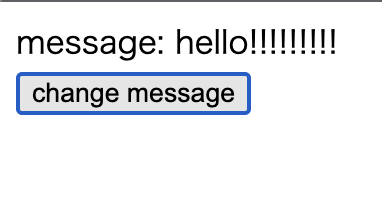組件 Props
開發者介面
讓我們從 props 開始.
讓我們思考一下最終的開發者介面.
讓我們考慮將 props 作為 setup 函式的第一個參數傳遞.
const MyComponent = {
props: { message: { type: String } },
setup(props) {
return () => h('div', { id: 'my-app' }, [`message: ${props.message}`])
},
}
const app = createApp({
setup() {
const state = reactive({ message: 'hello' })
const changeMessage = () => {
state.message += '!'
}
return () =>
h('div', { id: 'my-app' }, [
h(MyComponent, { message: state.message }, []),
])
},
})實現
基於此,讓我們思考一下我們想在 ComponentInternalInstance 中擁有的資訊.
我們需要指定為 props: { message: { type: String } } 的 props 定義,以及一個實際保存 props 值的屬性,所以我們添加以下內容:
export type Data = Record<string, unknown>
export interface ComponentInternalInstance {
// .
// .
// .
propsOptions: Props // 保存像 `props: { message: { type: String } }` 這樣的物件
props: Data // 保存從父組件傳遞的實際資料(在這種情況下,它將是像 `{ message: "hello" }` 這樣的東西)
}創建一個名為 ~/packages/runtime-core/componentProps.ts 的新檔案,內容如下:
export type Props = Record<string, PropOptions | null>
export interface PropOptions<T = any> {
type?: PropType<T> | true | null
required?: boolean
default?: null | undefined | object
}
export type PropType<T> = { new (...args: any[]): T & {} }在實現組件時將其添加到選項中.
export type ComponentOptions = {
props?: Record<string, any> // 添加
setup?: () => Function
render?: Function
}當使用 createComponentInstance 生成實例時,在生成實例時將 propsOptions 設定到實例中.
export function createComponentInstance(
vnode: VNode
): ComponentInternalInstance {
const type = vnode.type as Component;
const instance: ComponentInternalInstance = {
// .
// .
// .
propsOptions: type.props || {},
props: {},讓我們思考如何形成 instance.props.
在組件掛載時,根據 propsOptions 過濾 vnode 持有的 props.
使用 reactive 函式將過濾後的物件轉換為響應式物件,並將其分配給 instance.props.
在 componentProps.ts 中實現一個名為 initProps 的函式來執行這一系列步驟.
export function initProps(
instance: ComponentInternalInstance,
rawProps: Data | null,
) {
const props: Data = {}
setFullProps(instance, rawProps, props)
instance.props = reactive(props)
}
function setFullProps(
instance: ComponentInternalInstance,
rawProps: Data | null,
props: Data,
) {
const options = instance.propsOptions
if (rawProps) {
for (let key in rawProps) {
const value = rawProps[key]
if (options && options.hasOwnProperty(key)) {
props[key] = value
}
}
}
}在掛載時實際執行 initProps,並將 props 作為參數傳遞給 setup 函式.
const mountComponent = (initialVNode: VNode, container: RendererElement) => {
const instance: ComponentInternalInstance = (initialVNode.component =
createComponentInstance(initialVNode));
// init props
const { props } = instance.vnode;
initProps(instance, props);
const component = initialVNode.type as Component;
if (component.setup) {
instance.render = component.setup(
instance.props // 將 props 傳遞給 setup
) as InternalRenderFunction;
}
// .
// .
// .
}export type ComponentOptions = {
props?: Record<string, any>
setup?: (props: Record<string, any>) => Function // 接收 props
render?: Function
}此時,props 應該傳遞給子組件,所以讓我們在遊樂場中檢查它.
const MyComponent = {
props: { message: { type: String } },
setup(props: { message: string }) {
return () => h('div', { id: 'my-app' }, [`message: ${props.message}`])
},
}
const app = createApp({
setup() {
const state = reactive({ message: 'hello' })
return () =>
h('div', { id: 'my-app' }, [
h(MyComponent, { message: state.message }, []),
])
},
})但是,這還不夠,因為當 props 更改時渲染不會更新.
const MyComponent = {
props: { message: { type: String } },
setup(props: { message: string }) {
return () => h('div', { id: 'my-app' }, [`message: ${props.message}`])
},
}
const app = createApp({
setup() {
const state = reactive({ message: 'hello' })
const changeMessage = () => {
state.message += '!'
}
return () =>
h('div', { id: 'my-app' }, [
h(MyComponent, { message: state.message }, []),
h('button', { onClick: changeMessage }, ['change message']),
])
},
})要使此組件工作,我們需要在 componentProps.ts 中實現 updateProps 並在組件更新時執行它.
~/packages/runtime-core/componentProps.ts
export function updateProps(
instance: ComponentInternalInstance,
rawProps: Data | null,
) {
const { props } = instance
Object.assign(props, rawProps)
}~/packages/runtime-core/renderer.ts
const setupRenderEffect = (
instance: ComponentInternalInstance,
initialVNode: VNode,
container: RendererElement
) => {
const componentUpdateFn = () => {
const { render } = instance;
if (!instance.isMounted) {
const subTree = (instance.subTree = normalizeVNode(render()));
patch(null, subTree, container);
initialVNode.el = subTree.el;
instance.isMounted = true;
} else {
let { next, vnode } = instance;
if (next) {
next.el = vnode.el;
next.component = instance;
instance.vnode = next;
instance.next = null;
updateProps(instance, next.props); // 這裡如果螢幕更新了,那就沒問題.
現在,您可以使用 props 將資料傳遞給組件!做得很好!

到此為止的原始碼:
chibivue (GitHub)
作為附註,雖然這不是必需的,但讓我們實現接收 kebab-case props 的能力,就像原始 Vue 中一樣.
此時,創建一個名為 ~/packages/shared 的目錄,並在其中創建一個名為 general.ts 的檔案.
這是定義通用函式的地方,不僅適用於 runtime-core 和 runtime-dom.
按照原始 Vue,讓我們實現 hasOwn 和 camelize.
~/packages/shared/general.ts
const hasOwnProperty = Object.prototype.hasOwnProperty
export const hasOwn = (
val: object,
key: string | symbol,
): key is keyof typeof val => hasOwnProperty.call(val, key)
const camelizeRE = /-(\w)/g
export const camelize = (str: string): string => {
return str.replace(camelizeRE, (_, c) => (c ? c.toUpperCase() : ''))
}讓我們在 componentProps.ts 中使用 camelize.
export function updateProps(
instance: ComponentInternalInstance,
rawProps: Data | null,
) {
const { props } = instance
// -------------------------------------------------------------- 這裡
Object.entries(rawProps ?? {}).forEach(([key, value]) => {
props[camelize(key)] = value
})
}
function setFullProps(
instance: ComponentInternalInstance,
rawProps: Data | null,
props: Data,
) {
const options = instance.propsOptions
if (rawProps) {
for (let key in rawProps) {
const value = rawProps[key]
// -------------------------------------------------------------- 這裡
// kebab -> camel
let camelKey
if (options && hasOwn(options, (camelKey = camelize(key)))) {
props[camelKey] = value
}
}
}
}現在您應該也能夠處理 kebab-case 了.讓我們在遊樂場中檢查它.
const MyComponent = {
props: { someMessage: { type: String } },
setup(props: { someMessage: string }) {
return () => h('div', {}, [`someMessage: ${props.someMessage}`])
},
}
const app = createApp({
setup() {
const state = reactive({ message: 'hello' })
const changeMessage = () => {
state.message += '!'
}
return () =>
h('div', { id: 'my-app' }, [
h(MyComponent, { 'some-message': state.message }, []),
h('button', { onClick: changeMessage }, ['change message']),
])
},
})